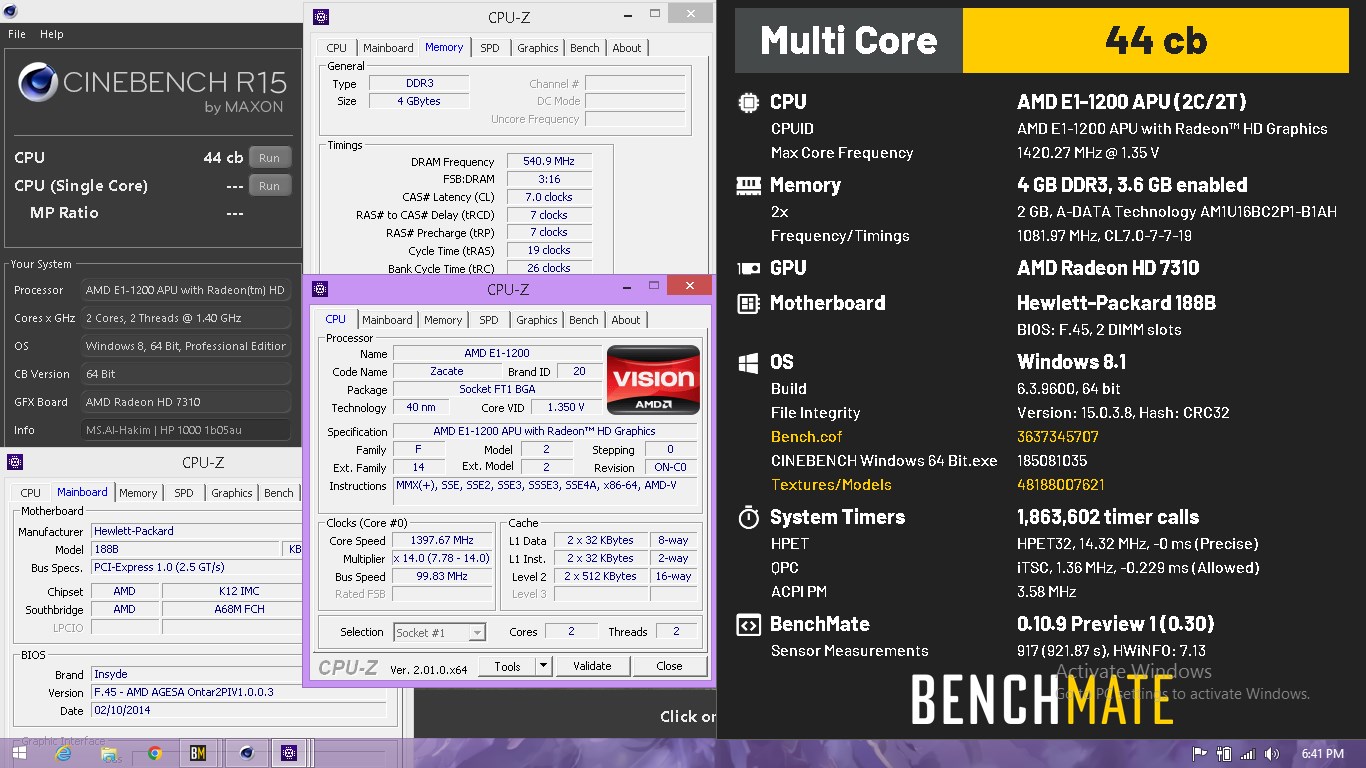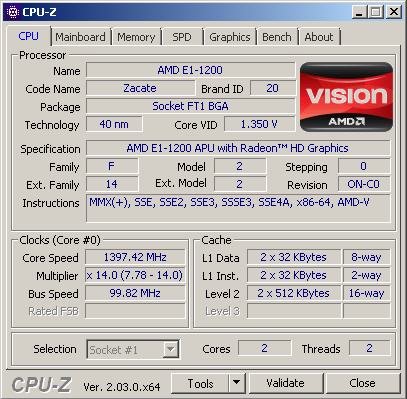Cinebench - R15 with BenchMate score 44 cb with a E1-1200
Thursday, 01 January 1970 07:00 | Update at null
Media Gallery
Screenshot

Device, Setup, etc



URL
https://hwbot.org/submission/4990218https://www.facebook.com/hakimnu.id/posts/3275946062638034
Information Detail
Hardware: AMD E1-1200
Specs:CPUID : AMD E1-1200 APU with Radeon(TM) HD Graphics
Architecture : x86
Codename : Zacate
L3 Cache : -
Clock : 1.4GHz
Core/Thread : 2/2
TDP : 18W
Technology : 40nm
Socket : FT1 BGA 413-Ball
IGPU : AMD Radeon HD 7310
See more specification...
Software: Cinebench - R15 with BenchMate
Score: 44 cb
About: Cinebench - R15 with BenchMateCinebench R15 with BenchMate is a benchmark version that combines the rendering performance of Cinebench R15 with the accuracy and measurement integrity of BenchMate, a benchmark validation tool developed specifically for overclockers and reviewers. This combination is ideal for users who want fair, consistent, and manipulation-free benchmarking results, especially when comparing performance between processors.
Like its standard version, Cinebench R15 uses the rendering engine from CINEMA 4D to test how quickly the CPU can render photorealistic 3D scenes with complex graphical elements, including over 300,000 polygons, area shadows, global illumination, and reflections. In multi-core mode, this benchmark utilizes all processor cores and threads to complete the rendering task as quickly as possible. The final score is given in points, reflecting the CPU's speed and efficiency in handling heavy workloads in parallel.
However, the main advantage of Cinebench R15 with BenchMate lies in its validation system. BenchMate ensures that the benchmark runs without any frequency manipulation, unrealistic turbo boost, or modified system latency, which could alter the final results. In other words, this benchmark is suitable for use as a transparent and reliable testing tool, whether for internal testing, content reviews, or overclocking competitions.
Additionally, BenchMate provides logging features for temperature, time, and frequency during the benchmark process, making it a comprehensive solution for measuring CPU performance with high accuracy. Therefore, Cinebench R15 with BenchMate is highly recommended for users seeking test results that are not only fast but also valid, stable, and reproducible.
Released in 2012 as part of the Brazos 2.0 family, the AMD E1-1200 is a power-efficient processor aimed at entry-level laptops. It has a 2 core and 2 thread configuration with a fixed clock speed of 1.4 GHz, with no support for Turbo Core technology. Built with a 40nm fabrication process, the E1-1200 has a TDP value of 18 watts-efficient enough for portable devices that emphasize low power consumption and longer battery life. Despite its limited performance, the E1-1200 was a popular choice in its day thanks to its affordable price and ability to handle light computing needs.
One of the main advantages of the AMD E1-1200 is the integrated Radeon HD 7310 GPU, which offers better graphics performance than Intel's entry-level graphics solutions at the time. This GPU has the ability to play HD resolution videos smoothly, as well as run light games such as Counter Strike 1.6, Plants vs Zombies, or other casual games with minimum graphics settings. That said, this combination of CPU and GPU is not intended for heavy-duty work such as video editing, 3D rendering, or modern gaming. Overall performance is more optimal when used for tasks such as browsing, streaming videos, accessing social media, typing documents, as well as basic office applications.
However, it should be noted that the AMD E1-1200 is less suitable for heavy multitasking, especially in modern operating systems like Windows 10. With a low clock speed and no Boost feature, users may experience lag or limitations when opening multiple applications at once. In tests using the HP 1000 1b05au laptop, this processor was paired with 4GB DDR3 single channel RAM (2 DIMM slots) and tested on Windows 7, Windows 8, and Windows 10 operating systems. The results show that the most optimal performance is achieved on Windows 7 or Windows 8, while in Windows 10 the system tends to be slow although it can still be used for basic needs. As such, the AMD E1-1200 can still be relied upon as a power-efficient and inexpensive solution for users with very light computing needs.
Hardware Detail:
Device: HP 1000 1b05au
RAM: 4GB DDR3 Single Channel 2 DIMM
OS: Windows 7, Windows 8, Windows 10
* Not Avaiable
